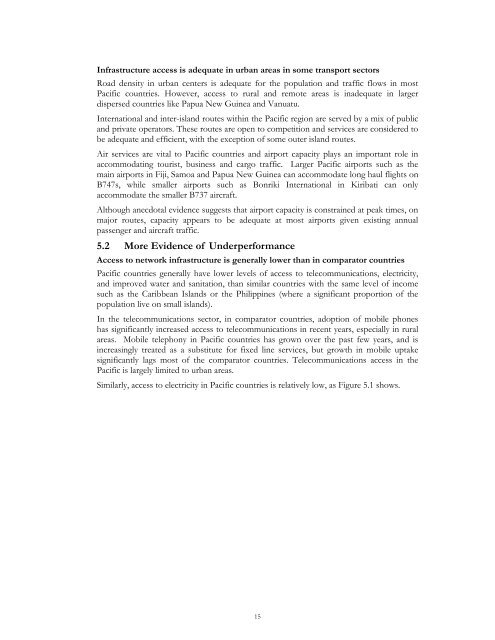EAP - The Pacific Infrastructure Challenge - World Bank (2006).pdf
EAP - The Pacific Infrastructure Challenge - World Bank (2006).pdf
EAP - The Pacific Infrastructure Challenge - World Bank (2006).pdf
You also want an ePaper? Increase the reach of your titles
YUMPU automatically turns print PDFs into web optimized ePapers that Google loves.
<strong>Infrastructure</strong> access is adequate in urban areas in some transport sectors<br />
Road density in urban centers is adequate for the population and traffic flows in most<br />
<strong>Pacific</strong> countries. However, access to rural and remote areas is inadequate in larger<br />
dispersed countries like Papua New Guinea and Vanuatu.<br />
International and inter-island routes within the <strong>Pacific</strong> region are served by a mix of public<br />
and private operators. <strong>The</strong>se routes are open to competition and services are considered to<br />
be adequate and efficient, with the exception of some outer island routes.<br />
Air services are vital to <strong>Pacific</strong> countries and airport capacity plays an important role in<br />
accommodating tourist, business and cargo traffic. Larger <strong>Pacific</strong> airports such as the<br />
main airports in Fiji, Samoa and Papua New Guinea can accommodate long haul flights on<br />
B747s, while smaller airports such as Bonriki International in Kiribati can only<br />
accommodate the smaller B737 aircraft.<br />
Although anecdotal evidence suggests that airport capacity is constrained at peak times, on<br />
major routes, capacity appears to be adequate at most airports given existing annual<br />
passenger and aircraft traffic.<br />
5.2 More Evidence of Underperformance<br />
Access to network infrastructure is generally lower than in comparator countries<br />
<strong>Pacific</strong> countries generally have lower levels of access to telecommunications, electricity,<br />
and improved water and sanitation, than similar countries with the same level of income<br />
such as the Caribbean Islands or the Philippines (where a significant proportion of the<br />
population live on small islands).<br />
In the telecommunications sector, in comparator countries, adoption of mobile phones<br />
has significantly increased access to telecommunications in recent years, especially in rural<br />
areas. Mobile telephony in <strong>Pacific</strong> countries has grown over the past few years, and is<br />
increasingly treated as a substitute for fixed line services, but growth in mobile uptake<br />
significantly lags most of the comparator countries. Telecommunications access in the<br />
<strong>Pacific</strong> is largely limited to urban areas.<br />
Similarly, access to electricity in <strong>Pacific</strong> countries is relatively low, as Figure 5.1 shows.<br />
15

















